The Flexible AC Current Transmission System Market is estimated to be valued at USD 1.7 billion in 2025 and is projected to reach USD 3.8 billion by 2035, registering a compound annual growth rate (CAGR) of 8.5% over the forecast period.
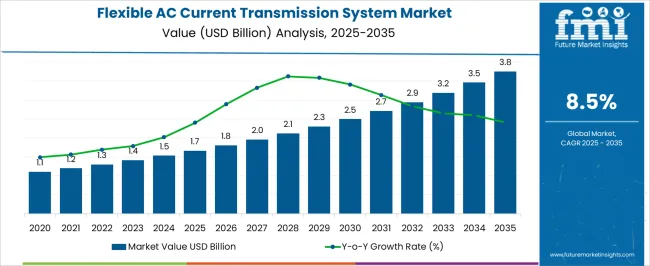
| Metric | Value |
|---|---|
| Flexible AC Current Transmission System Market Estimated Value in (2025 E) | USD 1.7 billion |
| Flexible AC Current Transmission System Market Forecast Value in (2035 F) | USD 3.8 billion |
| Forecast CAGR (2025 to 2035) | 8.5% |
The flexible AC current transmission system market is witnessing substantial growth as power systems increasingly require advanced solutions for voltage regulation, reactive power compensation, and system stability. The adoption of flexible AC transmission systems is being driven by the growing complexity of modern electrical grids, including the integration of renewable energy sources, increasing electricity demand, and the need to minimize transmission losses.
Advancements in power electronics, real-time monitoring technologies, and intelligent control systems are enhancing the performance and reliability of transmission networks. Rising investments in smart grid infrastructure and regulatory policies promoting energy efficiency are encouraging the deployment of flexible AC systems across utilities and industrial sectors.
The market is also benefiting from the shift toward digital control and modular designs, which enable easier upgrades, remote monitoring, and reduced maintenance requirements As utilities focus on improving grid resilience and reducing operational costs, the flexible AC current transmission system market is expected to experience steady expansion, driven by continuous innovation in compensation technologies, system components, and control strategies.
The flexible ac current transmission system market is segmented by compensation type, component, application, and geographic regions. By compensation type, flexible ac current transmission system market is divided into Static Synchronous Compensator (STATCOM), Static Var Compensator (SVC), Thyristor Controlled Breaking Reactor (TCSC), Thyristor Controlled Series Capacitor (TSC), Thyristor Switched Series Reactor (TSR), and Static Synchronous Series Compensator (SSSC). In terms of component, flexible ac current transmission system market is classified into Shunt Controller, Series Controller, Combined Series-Series Controller, and Combined Series-Shunt Controllers. Based on application, flexible ac current transmission system market is segmented into Electric Utilities Industry, Renewable Energy Industry, Metal & Mining Industry, Oil & Gas Industry, and Railway Industry. Regionally, the flexible ac current transmission system industry is classified into North America, Latin America, Western Europe, Eastern Europe, Balkan & Baltic Countries, Russia & Belarus, Central Asia, East Asia, South Asia & Pacific, and the Middle East & Africa.
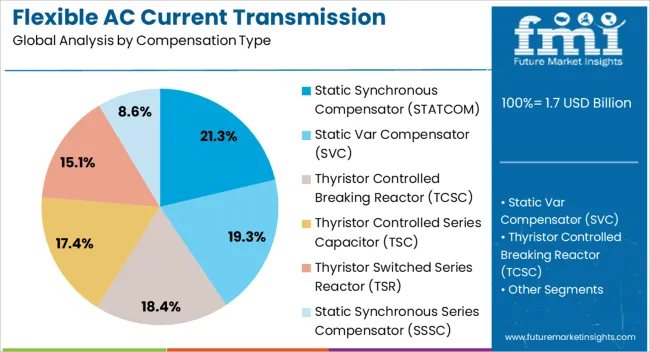
The static synchronous compensator segment is projected to hold 21.3% of the flexible AC current transmission system market revenue share in 2025, making it the leading compensation type. Its dominance is being supported by superior reactive power management capabilities, which enable real-time voltage regulation and improved grid stability. STATCOM systems are highly effective in mitigating voltage fluctuations in complex transmission networks, particularly where renewable energy sources introduce variability.
The segment benefits from enhanced operational efficiency and reduced harmonic distortion, allowing utilities to optimize energy distribution while minimizing equipment stress. Advanced power electronic components and digital control strategies enable precise performance tuning, further reinforcing adoption.
Growing awareness among grid operators about the advantages of rapid response compensation devices over conventional solutions has strengthened market share As modernization of transmission networks continues globally, STATCOM is being increasingly deployed across high-voltage and medium-voltage applications, providing enhanced flexibility, reliability, and efficiency, which cements its position as the leading compensation type in the market.
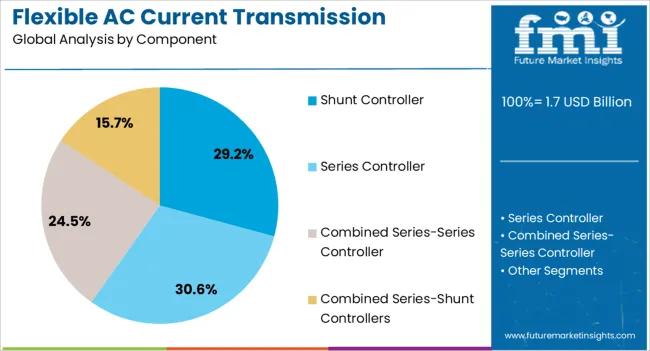
The shunt controller segment is anticipated to capture 29.2% of the flexible AC current transmission system market revenue share in 2025, making it the dominant component category. Its leadership is being driven by its critical role in maintaining voltage stability, controlling reactive power flow, and improving overall transmission efficiency.
Shunt controllers enable real-time coordination of flexible AC systems with grid conditions, allowing for precise adjustment of power flows and minimizing losses. The segment’s growth is further supported by increasing deployment in power networks requiring dynamic compensation and improved reliability.
Enhanced modularity and compatibility with advanced digital monitoring systems allow utilities to integrate shunt controllers seamlessly into existing infrastructure, optimizing performance without extensive retrofitting As electricity demand grows and grids become more complex, the need for robust and responsive voltage control components is increasing, reinforcing the adoption of shunt controllers across utilities and industrial applications globally.
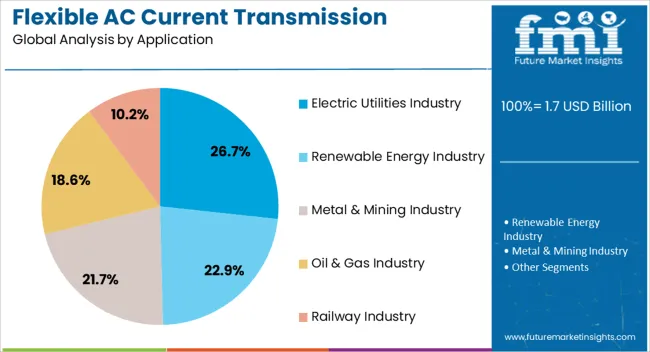
The electric utilities industry application segment is expected to hold 26.7% of the flexible AC current transmission system market revenue share in 2025, establishing it as the leading application area. Its dominance is being driven by the need to enhance transmission reliability, manage peak loads, and integrate renewable generation sources effectively. Flexible AC transmission systems in utilities support voltage stability, improve power quality, and enable more efficient grid operation.
Rising investments in smart grid modernization and regulatory mandates for energy efficiency are further boosting adoption. The segment is being reinforced by the requirement for scalable and modular solutions that can be adapted to evolving grid configurations without significant infrastructure changes.
The ability to remotely monitor, control, and optimize system performance in real time is providing utilities with operational flexibility and reduced maintenance costs As energy demand continues to rise globally and grid complexity intensifies, the electric utilities sector is expected to maintain its position as the primary application for flexible AC current transmission systems, driving continued market growth.
With growing trend of urbanization and industrialization, a significant rise in demand for electricity has been witnessed across the world. Thus, governments worldwide are increasingly focusing on undertaking initiatives for increasing the rate of electrification and strengthening power transmission, & distribution to meet the growing power demand.
For instance, according to the Ministry of Power, the Government of India has launched a Deendayal Upadhyaya Gram Jyoti Yojana (DDUGJY) scheme to enhance electrification, strengthen sub-transmission & distribution infrastructure, and improve the quality and reliability of power supply in rural areas.
Flexible AC current transmission systems are extensively used in numerous applications across cross power generation and distribution sectors, owing to its benefit such as faster control actions, enhanced power loading capability, and better power system security. Thus, a multiplicity of such initiatives is expected to create lucrative growth opportunities for the flexible AC current transmission system market.
Due to the complexities of flexible AC current transmission systems, the initial cost involved in the installation of these systems is relatively high, which is in turn, restraining the adoption of these technologies by utility and industries players.
In addition to this, increasing availability of low-cost alternatives such as phase-shifting transformers, switches, and others with similar functionality is hindering the sales of flexible AC current transmission systems.
Although, flexible AC current transmission systems offer numerous benefits, there are several complications and issues that are needed to be addressed for the successful installation of these systems on large scale such as exact fitting size and setting. This is further hampering the growth in the global market.
Future Market Insights states that the Asia Pacific is projected to emerge as the most remunerative market for flexible AC current transmission systems between 2025 and 2035.
Rising concerns regarding environmental sustainability and growing petroleum-based fuel prices have resulted in a rapid shift towards the production of green energy using renewable sources, especially across China and India. Hence, governments in these countries are undertaking numerous programs and initiatives to increase the production of renewable energy.
For instance, according to the India Brand Equity Foundation (IBEF), the Indian Government announced sanctioning US$ 616.76 Mn to the Indian Renewable Energy Development Agency Ltd. under the Production Linked Incentive (PLI) scheme for the development of solar energy production units.
In addition, the launch of massive green energy generation plants is expected to bolster the demand for electrical devices such as flexible AC current transmission systems across the Asia Pacific market.
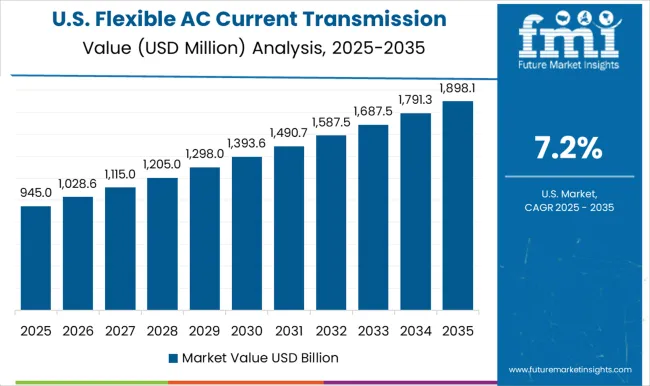
As per FMI, North America is projected to account for a significant share in the global flexible AC current transmission system market over the forecast period 2025-2035.
Increasing number of railway line extension projects across the USAand Canada is a primary factor fueling the demand for flexible AC current transmission systems. For instance, the USA has announced its plan allocated US$ 53.8 Bn under the Sound Transit 3 (ST3) Construction Project for expanding the country's existing link light railway system starting from the suburbs of Tacoma to West Seattle.
As flexible AC current transmission systems are increasingly used in railway infrastructures for controlling voltage fluctuations, providing fast reactive voltage support, and enhancing power supply ability, such projects are estimated to spur the sales in the North America market.
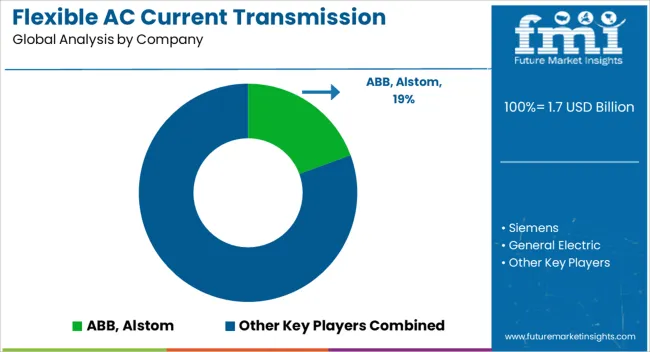
Some of the leading players in the global flexible AC current transmission systems market are ABB, Alstom, Eaton and Xian Electric Engineering, General Electric, Mitsubishi Electric, Toshiba, Siemens, America Superconductor Corporation, and others
Attributed to the presence of such high number of participants and increasing high performance product launches, the market is highly competitive.
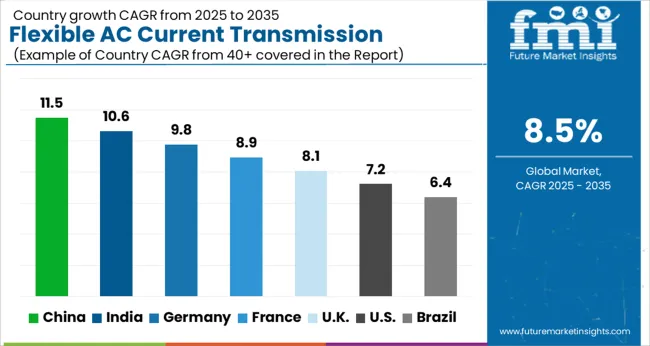
| Country | CAGR |
|---|---|
| China | 11.5% |
| India | 10.6% |
| Germany | 9.8% |
| France | 8.9% |
| UK | 8.1% |
| USA | 7.2% |
| Brazil | 6.4% |
The Flexible AC Current Transmission System Market is expected to register a CAGR of 8.5% during the forecast period, exhibiting varied country level momentum. China leads with the highest CAGR of 11.5%, followed by India at 10.6%. Developed markets such as Germany, France, and the UK continue to expand steadily, while the USAis likely to grow at consistent rates. Brazil posts the lowest CAGR at 6.4%, yet still underscores a broadly positive trajectory for the global Flexible AC Current Transmission System Market. In 2024, Germany held a dominant revenue in the Western Europe market and is expected to grow with a CAGR of 9.8%. The USAFlexible AC Current Transmission System Market is estimated to be valued at USD 604.7 million in 2025 and is anticipated to reach a valuation of USD 1.2 billion by 2035. Sales are projected to rise at a CAGR of 7.2% over the forecast period between 2025 and 2035. While Japan and South Korea markets are estimated to be valued at USD 79.1 million and USD 46.6 million respectively in 2025.
| Item | Value |
|---|---|
| Quantitative Units | USD 1.7 Billion |
| Compensation Type | Static Synchronous Compensator (STATCOM), Static Var Compensator (SVC), Thyristor Controlled Breaking Reactor (TCSC), Thyristor Controlled Series Capacitor (TSC), Thyristor Switched Series Reactor (TSR), and Static Synchronous Series Compensator (SSSC) |
| Component | Shunt Controller, Series Controller, Combined Series-Series Controller, and Combined Series-Shunt Controllers |
| Application | Electric Utilities Industry, Renewable Energy Industry, Metal & Mining Industry, Oil & Gas Industry, and Railway Industry |
| Regions Covered | North America, Europe, Asia-Pacific, Latin America, Middle East & Africa |
| Country Covered | United States, Canada, Germany, France, United Kingdom, China, Japan, India, Brazil, South Africa |
| Key Companies Profiled | ABB, Alstom, Siemens, General Electric, Mitsubishi Electric, Toshiba, Eaton and Xian Electric Engineering, and America Superconductor Corporation |
The global flexible ac current transmission system market is estimated to be valued at USD 1.7 billion in 2025.
The market size for the flexible ac current transmission system market is projected to reach USD 3.8 billion by 2035.
The flexible ac current transmission system market is expected to grow at a 8.5% CAGR between 2025 and 2035.
The key product types in flexible ac current transmission system market are static synchronous compensator (statcom), static var compensator (svc), thyristor controlled breaking reactor (tcsc), thyristor controlled series capacitor (tsc), thyristor switched series reactor (tsr) and static synchronous series compensator (sssc).
In terms of component, shunt controller segment to command 29.2% share in the flexible ac current transmission system market in 2025.






Our Research Products

The "Full Research Suite" delivers actionable market intel, deep dives on markets or technologies, so clients act faster, cut risk, and unlock growth.

The Leaderboard benchmarks and ranks top vendors, classifying them as Established Leaders, Leading Challengers, or Disruptors & Challengers.

Locates where complements amplify value and substitutes erode it, forecasting net impact by horizon

We deliver granular, decision-grade intel: market sizing, 5-year forecasts, pricing, adoption, usage, revenue, and operational KPIs—plus competitor tracking, regulation, and value chains—across 60 countries broadly.

Spot the shifts before they hit your P&L. We track inflection points, adoption curves, pricing moves, and ecosystem plays to show where demand is heading, why it is changing, and what to do next across high-growth markets and disruptive tech

Real-time reads of user behavior. We track shifting priorities, perceptions of today’s and next-gen services, and provider experience, then pace how fast tech moves from trial to adoption, blending buyer, consumer, and channel inputs with social signals (#WhySwitch, #UX).

Partner with our analyst team to build a custom report designed around your business priorities. From analysing market trends to assessing competitors or crafting bespoke datasets, we tailor insights to your needs.
Supplier Intelligence
Discovery & Profiling
Capacity & Footprint
Performance & Risk
Compliance & Governance
Commercial Readiness
Who Supplies Whom
Scorecards & Shortlists
Playbooks & Docs
Category Intelligence
Definition & Scope
Demand & Use Cases
Cost Drivers
Market Structure
Supply Chain Map
Trade & Policy
Operating Norms
Deliverables
Buyer Intelligence
Account Basics
Spend & Scope
Procurement Model
Vendor Requirements
Terms & Policies
Entry Strategy
Pain Points & Triggers
Outputs
Pricing Analysis
Benchmarks
Trends
Should-Cost
Indexation
Landed Cost
Commercial Terms
Deliverables
Brand Analysis
Positioning & Value Prop
Share & Presence
Customer Evidence
Go-to-Market
Digital & Reputation
Compliance & Trust
KPIs & Gaps
Outputs
Full Research Suite comprises of:
Market outlook & trends analysis
Interviews & case studies
Strategic recommendations
Vendor profiles & capabilities analysis
5-year forecasts
8 regions and 60+ country-level data splits
Market segment data splits
12 months of continuous data updates
DELIVERED AS:
PDF EXCEL ONLINE
HVAC System Analyzer Market Size and Share Forecast Outlook 2025 to 2035
Flexible Packaging Paper Market Size and Share Forecast Outlook 2025 to 2035
Backpack Systems Market Size and Share Forecast Outlook 2025 to 2035
Flexible Packaging Machinery Market Size and Share Forecast Outlook 2025 to 2035
Flexible Packaging Market Size and Share Forecast Outlook 2025 to 2035
Market Share Breakdown of Flexible Packaging Paper Manufacturers
System-On-Package Market Size and Share Forecast Outlook 2025 to 2035
AC Mitigation System Market
HVAC Control System Market Size and Share Forecast Outlook 2025 to 2035
Machine Vision System And Services Market Size and Share Forecast Outlook 2025 to 2035
Triac Dimming System Market Size and Share Forecast Outlook 2025 to 2035
Machine Control System Market Growth – Trends & Forecast 2025 to 2035
Flexible Plastic Packaging Market Size and Share Forecast Outlook 2025 to 2035
Flexible Plastic Packaging Industry Analysis in United States Size and Share Forecast Outlook 2025 to 2035
Market Share Distribution Among Flexible Plastic Packaging Manufacturers
Nutraceutical Flexible Packaging Market
EV Transmission System Market Size and Share Forecast Outlook 2025 to 2035
Eye Tracking System Market Forecast and Outlook 2025 to 2035
Microcurrent Facial Market Analysis & Forecast by Application, End-use, and Region Through 2035
Asia Pacific Flexible Glass Market Growth – Trends & Forecast 2025-2035

Thank you!
You will receive an email from our Business Development Manager. Please be sure to check your SPAM/JUNK folder too.
Chat With
MaRIA